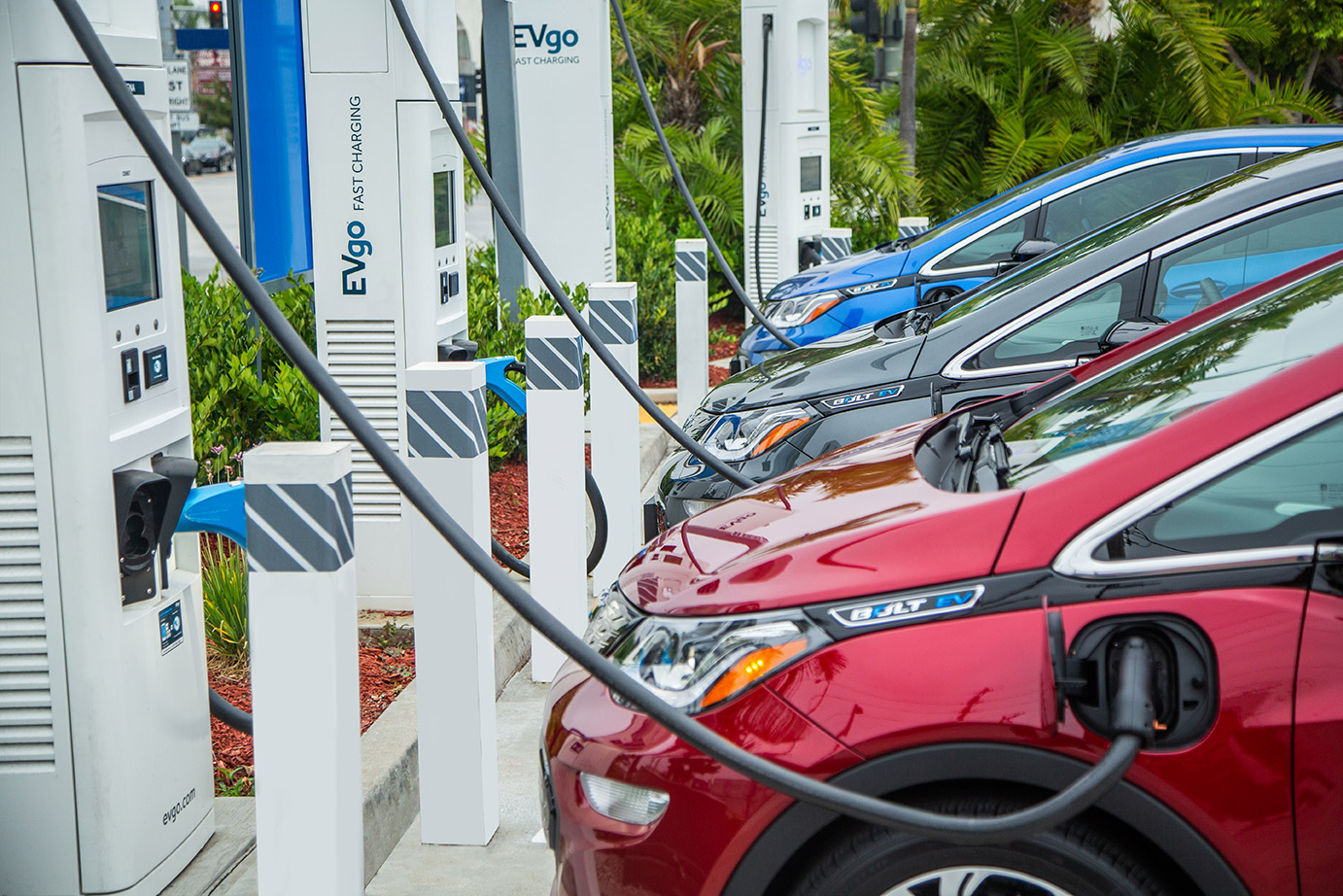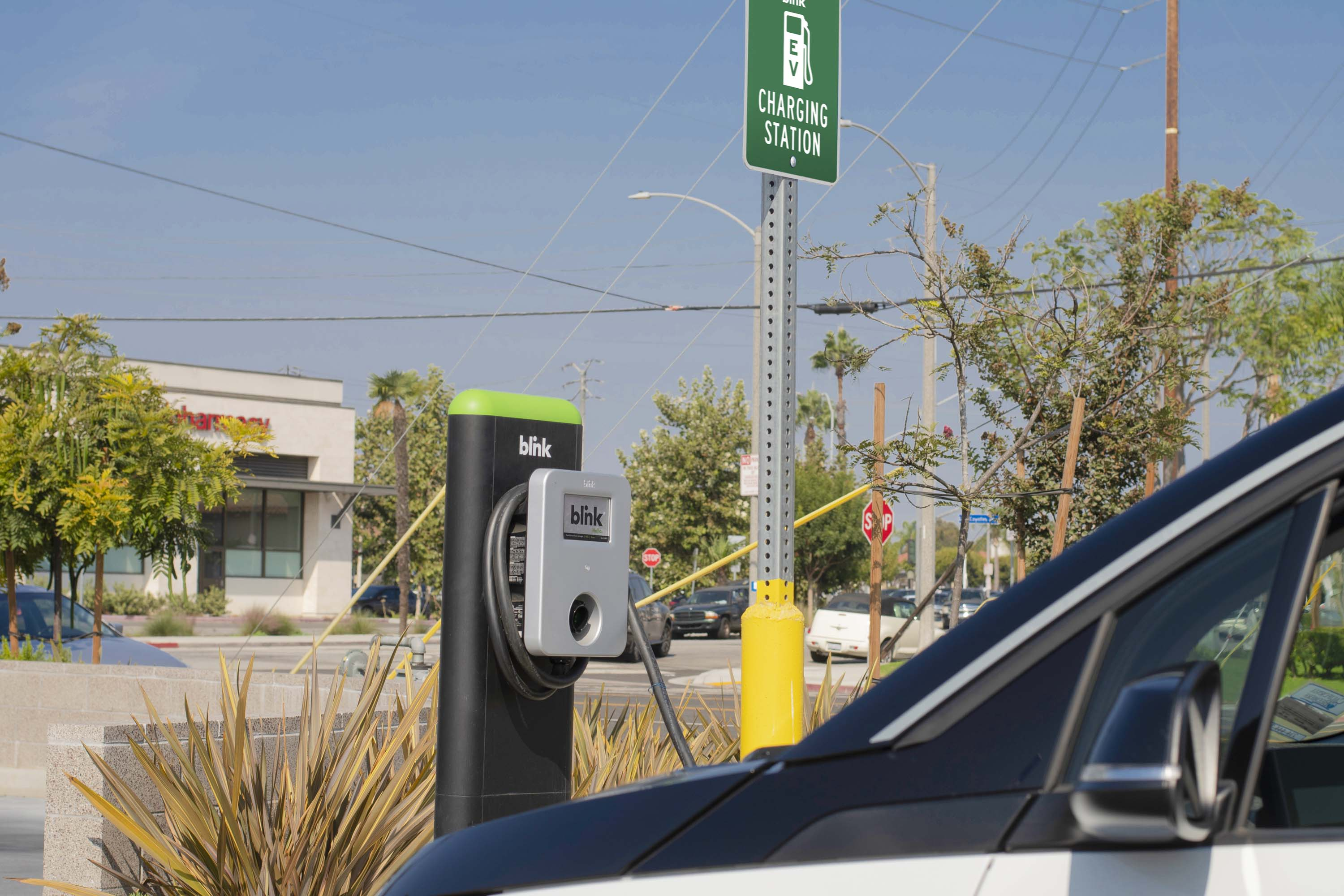Can stores and malls boost traffic and sales in the years ahead by installing more electric vehicle charging stations? It all depends on whether EVs, which are still a small part of the car market, can accelerate from buzz into the mainstream.
There are signs it could happen. In recent months, GM, Volvo and Volkswagen all have announced plans gradually to phase out combustion-engine vehicles. GM even hired Will Ferrell to tout its new EVs — and troll Norway — in a Super Bowl ad. Meanwhile, new EV models like the Volkswagen ID.4, BMW iX and Ford Mustang Mach-E, pictured at top, are giving drivers sexier choices. Toyota also plans to unveil several EV models this year. The Edison Electric Institute says the number of EVs on U.S. roads could reach 18.7 million by 2030, up from 1 million at the end of 2018. Globally, the number could grow by 36 percent annually to reach 245 million by 2030, more than 30 times today’s level, according to the International Energy Agency.
Real estate involvement
Already, the prospect of wider EV adoption is affecting some commercial real estate projects, says Michael Lee, a vice president for global architecture, planning and design firm CallisonRTKL. “For mixed-use properties, we’re seeing much more focus on providing EV charging within residential components,” the architect said. That includes a project in Canada with a parking garage that will accommodate a steep rise in demand for EV charging. “The developer is putting in the infrastructure and wants the capacity to convert, potentially, 100 percent of those residential parking stalls to rapid EV charging,” Lee said.
In Norway, the per-capita leader on EV adoption, the impact is visible at projects like Circle K’s massive new convenience store in the city of Bamble, said retail designer Joseph Bona, president of Bona Design Lab. “It’s designed to be a huge hub for EV charging, with the capacity for about 40 charging stations. They’ve got 28 of them in place right now, eight from Circle K and 20 from Tesla.”
Despite Ferrell’s trash-talking on behalf of the U.S. in that TV spot, Norway has lapped the U.S. many times over in the race to adopt EVs, and Bona says that gap won’t close anytime soon. “It’ll be years or maybe even decades. You have to remember that Norway is a small country with about 5 million people.” According to a Norway-based transportation research group, 54 percent of all new vehicles sold in the Scandinavian nation last year were electric. That compares to about 2 percent stateside during the same period, according to Atlas EV Hub.
Still, Grand View Research sees the $2 billion U.S. market for EV charging infrastructure growing by an average of 38.9 percent per year from now until 2028. The question for retailers and landlords is whether their parking lots should be part of that effort. Macerich has worked with the likes of Tesla, Electrify America and EVgo to install 267 EV charging stations across its 31-property portfolio, said executive vice president of operations Olivia Leigh.
Macerich’s Class-A properties are in dense, largely affluent markets where Teslas and other EVs are increasingly popular, such as Portland, Oregon; Sacramento, California; and Tysons Corner, Virginia. Retailers and landlords with similar holdings also are partnering with the likes of EVgo, which touts the power of charging stations to “attract new visitors, build brand loyalty and future-proof your business.” The company owns and operates 800 fast-charging stations in 34 states, and 2,700 more are in the works thanks to its new partnership with GM.

In its deals with retailers and landlords, EVgo covers all capital and operating expenses, as well as construction, permitting and maintenance. Customers include Simon, Kimco Realty, Cedar Realty Trust, CBL, Kroger, Whole Foods, Walmart, Walgreens, Albertsons and CVS.
EV charging company Blink offers different options for structuring a deal, said SVP of business development Michael Battaglia. For example, a retailer or landlord could buy the charging station outright. “When they do that, they can set the pricing on it and they keep 100 percent of the revenue it generates,” he said. In other cases, the shopping center owner or retail chain pays for the electrical infrastructure and Blink installs the EV charging station at no cost. “When we do that, we split the revenue that gets generated,” Battaglia said.
A single Blink charger in a good location can bring in hundreds of dollars a month as users charge their vehicles for anywhere from 30 minutes to an hour, he said. Blink’s retail customers include Starbucks, Whole Foods, Ikea, Walmart and McDonald’s. The company has about 3,600 networked charging stations in the U.S.

A Blink electric vehicle charging station in the parking lot of a Raising Cane’s fast-food chicken finger restaurant in Long Beach, California.
With networked chargers, Battaglia explains, drivers can use apps to find nearby stores or malls that have charging stations. Users also can pay via the Blink app, which will ping them when the charge is finished. “That allows them to go shopping and leave their car,” Battaglia said. Networks also give the host of the EV charger some useful back-end data. “It’s things like how much revenue I’m generating from the charging station, how many charging sessions per day are happening and my estimated carbon offset,” Battaglia said.
Blink also has sold about 9,000 non-networked units for use in residential real estate.
Synergy with solar
EV chargers sometimes are built with small solar canopies over them. Beyond providing some free energy from the sun, they can be aesthetically pleasing and make charging stations easier to find, says Will Arnold, COO of Quest Renewables, which designs and installs racking systems for solar canopies erected over parking lots and other structures. The combination can also send a message to visitors about the owner's environmental commitment, he adds. “Visually and emotionally, there is a connection between the two, but typically, they will both have their own utility agreement and will be independent, separate systems."
More important, combining EV chargers with solar can increase the value of the property by adding revenue streams, Arnold noted. Retailers and landlords also can add an energy-storage system to the mix to increase the financial benefits. Utilities charge higher rates at times of peak demand, and storage systems make it possible to access and store lower-rate grid energy for later use at charging stations and/or the building. “When you flatten that high-demand charge, it can have a big impact,” Arnold said.
Many mall owners and retailers indeed have installed rooftop or other solar systems along with EV chargers. According to Leigh, solar arrays at 13 Macerich properties now generate more than 16 million kilowatt-hours annually, enough to power 1,862 homes.
Brand benefits
Charging stations also can supplement marketing and messaging, which is part of the idea behind the EV charging program at LG-MRI, a joint venture between LG Electronics and Manufacturing Resources International, which makes outdoor LCD displays. LG-MRI’s BoldVu design combines a solar canopy with a charging station and a large visual display. Intel provides the computer processing. Retailers and landlords can use the system to show shoppers promotions, branded messaging, wayfinding information and the like, says LG-MRI vice president of sales Eric Hornsby. “One opportunity is to barter with that initial charging period,” he said. A retailer, for example, could offer to pay for the first five or 10 minutes of a shopper’s charging session if the customer makes a purchase. A landlord also could sell time on the LCD to retailers.
When crunching the numbers on charger installations, Hornsby adds, look for government financial incentives for EV charging infrastructure, a task that LG-MRI handles in the planning and logistics work it does in multi-party deals. “The utility may package funding and/or a rebate as part of the arrangement,” Hornsby said.
Just like cellphones: When you need a charge, you need a charge
Most EV drivers do the bulk of their charging at home or at work, but as Hornsby sees it, they will be on the lookout for other ways to keep enough juice in their cars. Shopping centers and retailers could cater to those drivers by adding more EV chargers. “I don’t just charge my cellphone when I go to sleep at night,” Hornsby said. “I charge it on my laptop, and I plug it into the wall when I’m in a conference room. Charging your vehicle is going to become a part of your day-to-day routine.”
On U.S. retail projects these days, anywhere from 2 to 5 percent of parking stalls may be outfitted with EV chargers, according to CallisonRTKL’s Lee. A raft of factors, especially government incentives and the basic economics of EVs, will determine whether installing many more chargers becomes a smart move for retailers and landlords, the architect said. “The trend is going to grow. It is just a question of how rapidly that will happen.”
And as EVs get more popular, landlords stand to benefit in another way, as well, by leasing space to EV sellers, says Macerich executive vice president of business development Ken Volk. The REIT’s portfolio includes seven Tesla stores or galleries, as well as showrooms for EV carmakers Lucid and Electra Meccanica. Volk said: “We’re continuing to see significant interest from electric vehicle companies as the reality of EVs becomes more mainstream.”
By Joel Groover
Contributor, Commerce + Communities Today